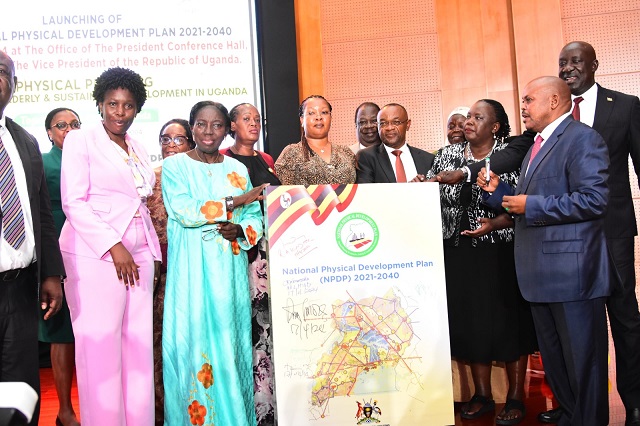
Kampala, Uganda | THE INDEPENDENT | The Government has launched a 20-year National Physical Development Plan aimed at ensuring that the whole of Uganda is a physical planning area.
The plan (NPDP) for the period 2021 to 2040 is funded by the International Development Association (IDA) of the World Bank.
The Lands, Housing and Urban Development Minister, Judith Nabakooba said the plan will cover the gap that made it hard to realize the objectives under the Comprehensive National Development Planning Framework, the National Development Plan III, and Vision 2040.
She says this plan is critical as far as the strategic location of our cities, key infrastructure, and orderly and sustainable use of land are concerned, especially if all its pillars are implemented well.
The NPDP is expected to drive the reorganizing of the limited land and come up with strategies for effective land utilization given that land is constant while the demand for its uses is ever increasing.
The plan is aligned to the Vision 2040, which aims at transforming Uganda from a predominantly peasant and low-income country to a competitive, middle-income, and modern industrialized nation.
Specific expected achievements of the plan include increased productivity in Agriculture with agro-processing industries and linkage to export markets, properly serviced industrial sites on infrastructure corridors connected to production areas, and the prospering of urban areas within the above pattern to become engines of economic growth.
Vice President Jessica Alupo, who was represented by First Deputy Prime Minister, Rebecca Kadaga said the long-term plan is important as a response to the growing population of the country. Uganda’s population is expected to grow from about 50 million today, to 70 million in 25 years.
The National Development Plan is also expected to act as a guide in safeguarding the protected areas and avoiding the degradation of natural resources.
A concept note to the document says that overall, national-level spatial decisions have not been guided by a well-thought-out comprehensive spatial framework, which has negatively impacted the overall development efforts.
“This has negated the optimal utilization of land and land-based resources, efficiency, and effectiveness of infrastructure networks, as well as undermining the integrity of the environment, especially the eco-sensitive areas,” it says.
The NPDP provides the analytical parameters for the planned allocation, use, and management of the country’s land and other physical resources, as well as the most efficient location of infrastructure, towns, and cities, and how they link to the surrounding rural areas.
This makes local governments central to the implementation of this plan. The Minister of State for Urban Development, Obiga Kania, urged the local leaders to use it to ensure well-developed settlements.
Local Government Minister, Raphael Magyezi however said it is hard for the local governments to play a critical role when they have very limited financial powers.
Magezi wondered how the Local Governments would be expected to develop their districts and other areas as per their mandate, when they are being suffocated financially, despite the laws giving them powers and mandates.
He criticized the practice of requiring the Local Governments to remit to the center the money they have collected, and worse still when they collect more than their budget.
Magyezi said remitting that money back to the LGs is another lengthy bureaucratic process.
The government plans to start giving local governments a grant for physical planning, starting with 5 billion shillings next year. In to Minister Magyezi’s concern, Deputy Premier, Kadaga assured him and the leaders of local and urban governments of the ongoing plan to have this streamlined, adding that the cabinet had already directed the Ministry of Finance, Planning and Economic Development to that effect.
The Plan is also aimed at encouraging the sustainable growth of the Greater Kampala Metropolitan Area (GKMA) and other cities, municipalities and towns.
The urban development will also encourage the growth of rural areas by adopting influential urban development approaches.
This closely ties in with the GKMA Urban Development Program and the ongoing Spatial Planning intervention at different levels and areas for example the USMID supporting various cities and municipalities and the GKMA development strategy with support from the Development Partners – JICA.
It also recognizes the need for equitable access to resources through rational distribution of the country’s resources and by providing equal opportunities for all in the use and acquisition of land and other resources.
*****
URN
 The Independent Uganda: You get the Truth we Pay the Price
The Independent Uganda: You get the Truth we Pay the Price





